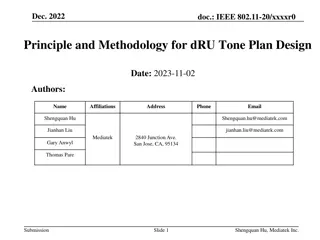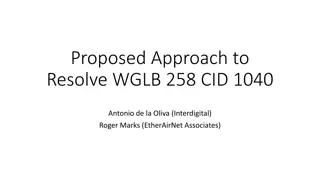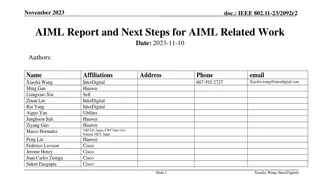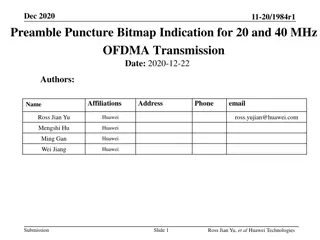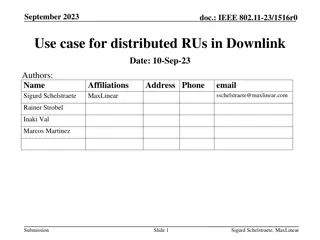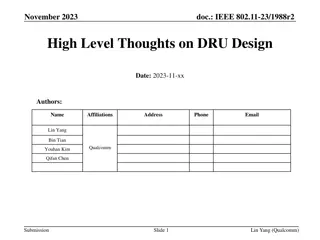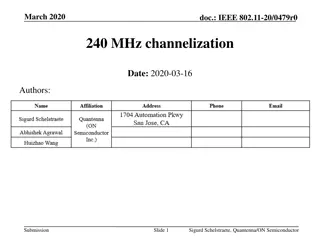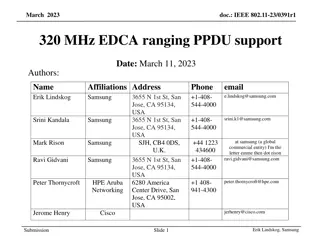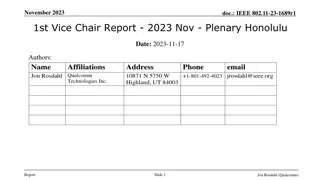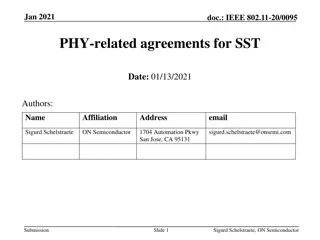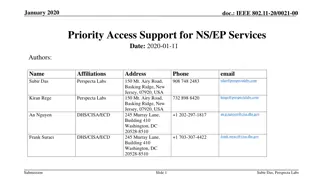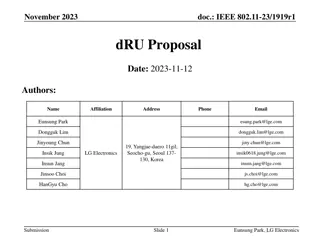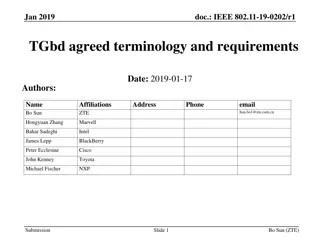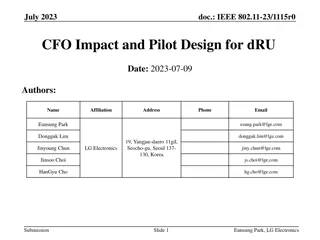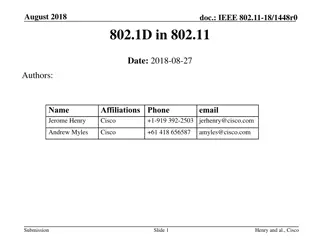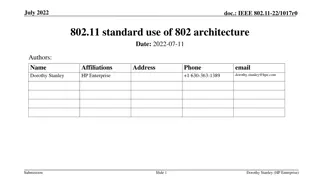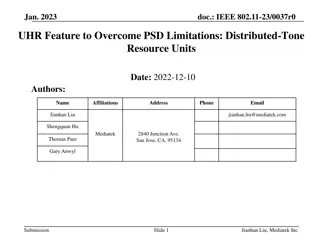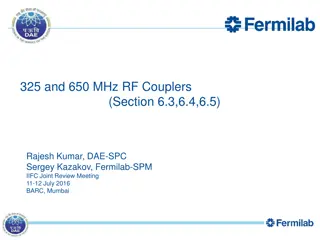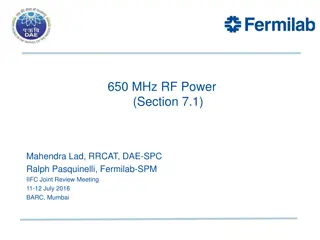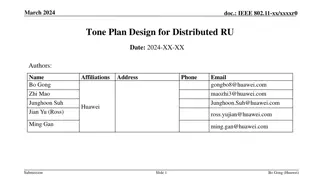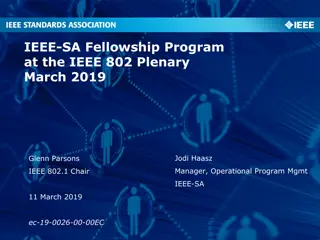IEEE 802.11-24/0078r1 dRU Design Approach for 20 MHz
Introduction to the design approach for Distributed Resource Units (dRUs) in the IEEE 802.11-24/0078r1 document for achieving the TGbn PAR goal of Rate-vs-Range. The focus is on designing resource units with low power spectral density to enhance transmit power per tone efficiently. Various tone plan design methods are discussed, with emphasis on achieving uniform distribution and meeting specific requirements for pilot placement.
Download Presentation

Please find below an Image/Link to download the presentation.
The content on the website is provided AS IS for your information and personal use only. It may not be sold, licensed, or shared on other websites without obtaining consent from the author.If you encounter any issues during the download, it is possible that the publisher has removed the file from their server.
You are allowed to download the files provided on this website for personal or commercial use, subject to the condition that they are used lawfully. All files are the property of their respective owners.
The content on the website is provided AS IS for your information and personal use only. It may not be sold, licensed, or shared on other websites without obtaining consent from the author.
E N D
Presentation Transcript
January 2024 doc.: IEEE 802.11-24/0078r1 A dRU Design Approach for 20 MHz Date: 2024-01-29 Authors: Name Affiliations Address Phone email Thomas Handte Thomas.Handte@sony.com Yusuke Tanaka Yusuke.YT.Tanaka@sony.com Salvatore Talarico Salvatore.Talarico@sony.com Dana Ciochina Sony Group Corporation Daniel Verenzuela Ken Tanaka Kosuke Aio Ryuichi Hirata Qing Xia Submission Slide 1 Thomas Handte (Sony), et al.
January 2024 doc.: IEEE 802.11-24/0078r1 Introduction Distributed Resource Units (dRUs) have been discussed to achieve TGbn PAR goal Rate-vs-Range (RvR) [1,2] The goal of dRU is to design resource units (RUs) with low power spectral density Lowering power spectral density is key for enhancing transmit power per tone with low number of active carriers [1,4] Past submissions address various desired properties of dRU tone plans [3-6], e.g., dRUs should have same size as regular resource units (rRUs), same DC tones, same guard bands dRUs tone plans should be ideally uniformly distributed [5,6] Possibility to schedule dRUs of different size without overlap In this submission, we present a dRU design approach for 20 MHz The dRU tone plan designed with this approach meets the above requirements, and maximizes the minimum tone separation distance Submission 2 Thomas Handte (Sony), et al.
January 2024 doc.: IEEE 802.11-24/0078r1 Comparison to past submissions Four different tone plan design methods have been discussed and analyzed in [6] Global Dtm , Tone Group Based , Perfect Uniformly Distribution , 26-tone RU Based This approach is closely related to 26-tone RU Based approach The tone plan proposed in here has perfectly uniform distribution for 26-tone dRUs has near-uniform distribution for dRUs of size > 26 tones has very simple notation has a hierarchical structure i.e., a large size dRU can be obtained by combining two small size dRUs The desired requirements [3-6] of a dRU tone plan are met On top, we suggest the requirement that each dRU has approximately 50% even indices equally distributed over the entire bandwidth This requirement is important for pilot placement Same pilots may be used for 2x and 4x UHR-LTF (as in HE and EHT) Submission 3 Thomas Handte (Sony), et al.
January 2024 doc.: IEEE 802.11-24/0078r1 Design approach for 20 MHz (1/2) Define a tone plan for the least number of dRUs in 20 MHz (i.e. two 106-tone and one 26-tone dRUs) Start with set of available tone indices > 0 (not including DC and guard tones) Tone indices < 0 are obtained by mirroring Select 13 tones with a tone separation distance of 9, resulting in the 26-tone dRU (dRU-A) Choose starting index such that 13 tones can be obtained Out of the remaining tones assign alternately 53 tones to two dRUs, resulting in two 106- tone dRUs (dRU-B, dRU-C) Any leftover tones are set to zero Submission 4 Thomas Handte (Sony), et al.
January 2024 doc.: IEEE 802.11-24/0078r1 Design approach for 20 MHz (2/2) Create tone plans for dRUs of smaller size by subsampling of a larger dRU Start with the set of tones indices >0 of an originating dRU larger than 26 tones Assign alternately N/2 tones to two dRUs, resulting in two N-tone dRUs (dRU-p1, dRU-p2) E.g. N=52 or N=26 Any leftover tones may be set to zero at arbitrary position The placement of leftover tones should consider that any lowest tone index >0 meets the minimum distance requirement after mirroring at DC Submission 5 Thomas Handte (Sony), et al.
January 2024 doc.: IEEE 802.11-24/0078r1 Example (1/2) Boundary conditions to match HE/EHT PPDU format, 20MHz DC tones -3 3 Guard tones -128 -123, 123 127 Symmetry to DC Indices of two 106-tone and one 26-tone dRU Excerpt of positive indices only (complete tone plans see appendix) dRU-A: 11, 20, 29, , 110, 119 dRU-B: 4, 6, 8, 10, 13, 15, 17, 19, 22, 24, , 116, 118, 121 dRU-C: 5, 7, 9, 12, 14, 16, 18, 21, 23, 25, , 117, 120, 122 Properties About 50% of each dRU tones have even indices There is a tone separation distance of at least 2 (106 tone) or equal 9 (26 tone) 25% of the tones of the 106-tone dRU have a tone separation distance of 3 [=11:9:119] (26 tone) (106 tone) (106 tone) Submission 6 Thomas Handte (Sony), et al.
January 2024 doc.: IEEE 802.11-24/0078r1 Example (2/2) Creation of smaller dRU sizes 52-tone dRUs Originating dRU-B: => dRU-B-p1: => dRU-B-p2: index 4 of originating dRU-B set to zero (leftover tone) 26-tone dRUs Originating dRU-B-p1: 8, 13, 17, 22, 26, , 116, 121 => dRU-B-p1-p1: 8, 17, , 116 => dRU-B-p1-p2: 13, 22, , 121 Properties About 50% of each dRU tones have even indices There is a tone separation distance of at least 4 (52 tone) or equal 9 (26 tone) ~50% of the tones of the 52-tone dRU have a tone separation distance of 5 4, 6, 8, 10, 13, 15, 17, 19, 22, 24, , 116, 118, 121 8, 13, 17, 22, 26, , 116, 121 6, 10, 15, 19, 24, , 114, 118 (106 tone) (52 tone) (52 tone) (52 tone) (26 tone) (26 tone) [=8:9:116] [=13:9:121] Submission 7 Thomas Handte (Sony), et al.
January 2024 doc.: IEEE 802.11-24/0078r1 Illustration guard tones DC tones leftover tone leftover tone Submission 8 Thomas Handte (Sony), et al.
January 2024 doc.: IEEE 802.11-24/0078r1 Properties The tone indices have properties that can be used to simplify notation 26-tone dRU tone indices can be written as ??:9:?? ?? and ?? depend on dRU index ? 52-tone dRU tone indices can be written as a combination of two 26-tone dRUs i.e., ??:9:?? ??:9:?? 106-tone dRU tone indices can be written as a combination of two 52-tone dRUs However, there is either one different start (?? ??:9:?? ??:9:?? ??:9:?? ?? ?? Starting indices ? and stopping indices ? can be found in Appendix 106) or one different stop (?? 106:9:?? or ??:9:?? ??:9:?? ??:9:?? ??:9:?? 106) index, i.e., 106 106= ?? 9 and ?? 106= ??+ 9 The tone indices have implementation-friendly properties Maximized minimum tone separation distance reduces effect of sidelobes in frequency domain Achievable gain is larger compared to approaches with tones in immediate vicinity (see Appendix) Submission 9 Thomas Handte (Sony), et al.
January 2024 doc.: IEEE 802.11-24/0078r1 Conclusion We presented a distributed resource unit (dRU) design approach for 20 MHz The proposed approach is closely related to 26-tone RU Based design method of [6] The suggested tone plan meets the following requirements Same number of tones as regular RUs dRUs of different size can be scheduled without overlap Symmetry to DC, same DC tones and guard band as 20 MHz regular RUs Almost uniform distribution of tones 26-tone dRUs are uniformly distributed Each dRU has approx. 50% even tones Can use same pilots for 2xUHR-LTF and 4xUHR-LTF Maximized minimum tone separation distance => minimized power spectral density The proposed tone plan may act as a reference for dRU development Tone plan is provided in Appendix Submission 10 Thomas Handte (Sony), et al.
January 2024 doc.: IEEE 802.11-24/0078r1 References [1] 11-23/0480 UHR proposed PAR [2] 11-23/0037 UHR Feature to Overcome PSD Limitations Distributed-Tone Resource Units [3] 11-23/1117 dRU Signaling for UHR [4] 11-23/1919 dRU Proposal [5] 11-23/2020 High Level Perspective on Distributed Tone RU for 11bn [6] 11-23/2021 Principle and Methodology for dRU Tone Plan Design Submission 11 Thomas Handte (Sony), et al.
January 2024 doc.: IEEE 802.11-24/0078r1 APPENDIX Submission 12 Thomas Handte (Sony), et al.
January 2024 doc.: IEEE 802.11-24/0078r1 Tone plan (1/3) 2x 106 + 1x 26 tones dRU-A: 11, 20, 29, 38, 47, 56, 65, 74, 83, 92, 101, 110, 119 = 11:9:119 dRU-B: 4, 6, 8, 10, 13, 15, 17, 19, 22, 24, 26, 28, 31, 33, 35, 37, 40, 42, 44, 46, 49, 51, 53, 55, 58, 60, 62, 64, 67, 69, 71, 73, 76, 78, 80, 82, 85, 87, 89, 91, 94, 96, 98, 100, 103, 105, 107, 109, 112, 114, 116, 118, 121 = 8:9:116, 6:9:114, 10:9:118, and 4:9:121 dRU-C: 5, 7, 9, 12, 14, 16, 18, 21, 23, 25, 27, 30, 32, 34, 36, 39, 41, 43, 45, 48, 50, 52, 54, 57, 59, 61, 63, 66, 68, 70, 72, 75, 77, 79, 81, 84, 86, 88, 90, 93, 95, 97, 99, 102, 104, 106, 108, 111, 113, 115, 117, 120, 122 = 9:9:117, 7:9:115, 12:9:120, and 5:9:122 (26 tone) (106 tone) (106 tone) Note: ?( ?) = ?(?) for ? 1 Submission 13 Thomas Handte (Sony), et al.
January 2024 doc.: IEEE 802.11-24/0078r1 Tone plan (2/3) 4x 52 + 1x 26 tones dRU-A: = 11:9:119 dRU-B-p1: = 8:9:116 and 13:9:121 dRU-B-p2: = 6:9:114 and 10:9:118 dRU-C-p1: = 5:9:113 and 9:9:117 dRU-C-p2: = 7:9:115 and 12:9:120 Note: ?( ?) = ? ? for ? 1 11, 20, 29, 38, 47, 56, 65, 74, 83, 92, 101, 110, 119 (26 tone) 8, 13, 17, 22, 26, 31, 35, 40, 44, 49, 53, 58, 62, 67, 71, 76, 80, 85, 89, 94, 98, 103, 107, 112, 116, 121 (52 tone) 6, 10, 15, 19, 24, 28, 33, 37, 42, 46, 51, 55, 60, 64, 69, 73, 78, 82, 87, 91, 96, 100, 105, 109, 114, 118 (52 tone) 5, 9, 14, 18, 23, 27, 32, 36, 41, 45, 50, 54, 59, 63, 68, 72, 77, 81, 86, 90, 95, 99, 104, 108, 113, 117 (52 tone) 7, 12, 16, 21, 25, 30, 34, 39, 43, 48, 52, 57, 61, 66, 70, 75, 79, 84, 88, 93, 97, 102, 106, 111, 115, 120 (52 tone) Submission 14 Thomas Handte (Sony), et al.
January 2024 doc.: IEEE 802.11-24/0078r1 Tone plan (3/3) 9x 26 tones dRU-A: dRU-B-p1-p1: dRU-B-p1-p2: dRU-B-p2-p1: dRU-B-p2-p2: dRU-C-p1-p1: dRU-C-p1-p2: dRU-C-p2-p1: dRU-C-p2-p2: Note: ?( ?) = ?(?) for ? 1 11, 20, 29, 38, 47, 56, 65, 74, 83, 92, 101, 110, 119 (26 tone) = 11:9:119 8, 17, 26, 35, 44, 53, 62, 71, 80, 89, 98, 107, 116 (26 tone) = 8:9:116 13, 22, 31, 40, 49, 58, 67, 76, 85, 94, 103, 112, 121 (26 tone) = 13:9:121 6, 15, 24, 33, 42, 51, 60, 69, 78, 87, 96, 105, 114 (26 tone) = 6:9:114 10, 19, 28, 37, 46, 55, 64, 73, 82, 91, 100, 109, 118 (26 tone) = 10:9:118 5, 14, 23, 32, 41, 50, 59, 68, 77, 86, 95, 104, 113 (26 tone) = 5:9:113 9, 18, 27, 36, 45, 54, 63, 72, 81, 90, 99, 108, 117 (26 tone) = 9:9:117 7, 16, 25, 34, 43, 52, 61, 70, 79, 88, 97, 106, 115 (26 tone) = 7:9:115 12, 21, 30, 39, 48, 57, 66, 75, 84, 93, 102, 111, 120 (26 tone) = 12:9:120 Submission 15 Thomas Handte (Sony), et al.
January 2024 doc.: IEEE 802.11-24/0078r1 Power Spectral Density of 52-tone dRU Comparison of design approaches Left: Maximized minimum tone separation distance, dRU-B-p1 (as defined in slide 14) Right: Exemplary tone grouping, dRU indices: 8, 9, 17, 18, 26, 27, 35, 36, , 108, 116, 117 Approach of maximized minimum tone separation distance results in more flat power spectral density and higher gain Probability of occurrence Probability of occurrence Submission 16 Thomas Handte (Sony), et al.









